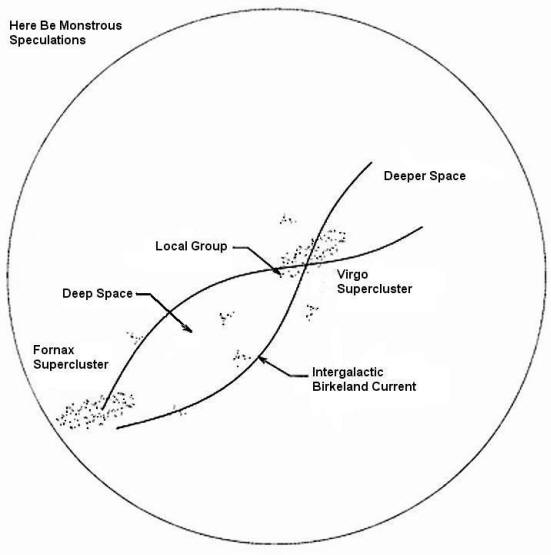In the consensus
view, the structure of the
observable universe is depicted by a
filigree of galaxies filling the
void with a foam of bubbles.In
previous Thunderbolts Picture of the Day articles, we have taken issue with
the current theories of large-scale structure that are based on cosmological
distance assumptions. Rather than interpreting a galaxy’s redshift to be an
indicator of its distance, Halton Arp and others
have shown that this assumption is untenable. Redshift is more likely an
indicator of ancestry. If all the errant galaxies on the consensus depiction are
brought back to their “genealogical distances,” what would the view of the
observable universe look like?
The Electric Universe proposes that clusters of galaxies are pinches in a
supergalactic Birkeland current. The usual morphology of a Birkeland current is
a double helix, or a hierarchy of double helices. With greater resolution, each
filament of a current is, at a smaller scale, a tube of filaments which, in
pairs, tend to spiral around a common axis.
We can assume, based on rough approximations, that every galaxy, QSO, Abell
Cluster, x-ray or radio-emitting cloud in the direction of the
Virgo Supercluster is located in that supercluster. The
Local Cluster, which includes the Andromeda galaxy (M31), M33, the higher-redshift
dwarf and peculiar galaxies extending along the spin axis of M31, as well as the
hydrogen clouds along that line (with which the higher-redshift objects are
interacting), and including our Milky Way galaxy, appears to be an outlying
member of the Virgo Supercluster.
On the opposite side of the sky lies the
Fornax Supercluster, an apparent mirror image of the Virgo Supercluster. If
we assume that it is approximately the same size as the Virgo Supercluster, its
smaller angular diameter would indicate that it is farther away.
If the Fornax and Virgo Superclusters are pinches in the same
largest-observable-scale Birkeland current, there could be more superclusters
beyond Fornax and Virgo, but they would be obscured by Fornax and Virgo. Perhaps
there would be other Birkeland currents, with pinched superclusters along them,
running parallel to the Fornax-Virgo filament, but they would be too far away
and too faint for us to see with present instruments.
We can imagine an infinite progression of such filaments or an arbitrary end
with the one we see (in part). The part of the one we see must be part of a
circuit, but from whence it comes and to whither it goes we can again only
imagine. Somewhere there must be a generator or a coupling with another circuit,
which leaves speculation piqued but unconstrained.
By Mel Acheson







